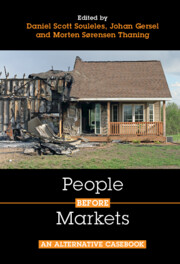Book contents
- People Before Markets
- People Before Markets
- Copyright page
- Dedication
- Contents
- Contents by Topic
- Authors
- 1 Introduction: Why Are You Here?
- 2 Some Philosophical Help with “Neoliberalism”
- Part I Our World
- Part II Our Lives
- 12 Why Do Some People Want to Manage Human Fertility?
- 13 How Should Childbirth Happen?
- 14 Who Is Responsible for Children’s Food?
- 15 How Should We Care for the Elderly?
- 16 How Are People Who Take Drugs Treated?
- 17 How Should We Design Access to a Healthcare System?
- Part III Our Work
- Index
- References
13 - How Should Childbirth Happen?
from Part II - Our Lives
Published online by Cambridge University Press: 27 October 2022
- People Before Markets
- People Before Markets
- Copyright page
- Dedication
- Contents
- Contents by Topic
- Authors
- 1 Introduction: Why Are You Here?
- 2 Some Philosophical Help with “Neoliberalism”
- Part I Our World
- Part II Our Lives
- 12 Why Do Some People Want to Manage Human Fertility?
- 13 How Should Childbirth Happen?
- 14 Who Is Responsible for Children’s Food?
- 15 How Should We Care for the Elderly?
- 16 How Are People Who Take Drugs Treated?
- 17 How Should We Design Access to a Healthcare System?
- Part III Our Work
- Index
- References
Summary
One feature of neoliberal market imperialism is the idea that no corner of life should be off limits from market-based competition and profit. Rather predictably, this sort of economic thinking has found its way into the provision of healthcare, even in the context of countries with socialized, nationalized healthcare such as the United Kingdom. Here, Shapiro examines what happens to care for mothers and children in the United Kingdom after the introduction of neoliberal reforms and compares it to Sweden, both ostensibly national systems, but differing in their degree of market creep. Shapiro makes use of a legal, human-rights-based frame of analysis to show that birth in Sweden is far better for human well-being than it is in the UK. In terms of the overarching theme of the book, the chapter is an example of the advantages of increased government planning against neoliberal orthodoxy. Her analysis also points to the alliance between neoliberal austerity policies and the defense of traditional conservative “family values.”
- Type
- Chapter
- Information
- People before MarketsAn Alternative Casebook, pp. 249 - 280Publisher: Cambridge University PressPrint publication year: 2022



